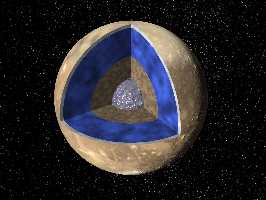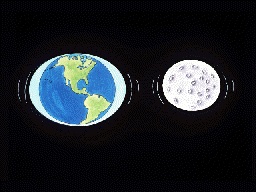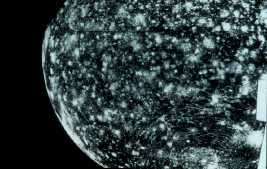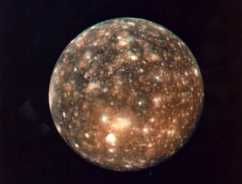This drawing shows the evolution of Callisto.
Click on image for full size
NASA
Evolution of Callisto
Most of the moons and planets formed by accretion of rocky material and volatiles out of the primitive solar nebula and soon thereafter they differentiated.
Measurements by the Galileo spacecraft have been shown that Callisto is completely homogeneous inside, and never differentiated. This means that, unlike Ganymede, Callisto probably never warmed inside enough to allow for the materials to separate. Planets gain heat by many means. The fact that Callisto never warmed could mean one of many things:
The lack of warmth prevented any movements of the crust which would have changed the appearance of the surface over time.
You might also be interested in:

Differentiation is a scientific term which really means "to separate". In their earliest history, elements which comprised the planets and moons would part into separate regions, if the body was warm enough.
...more
The force of gravity caused by an object gets weaker as you move farther away from that object. In this picture, the Earth is pulling on the Moon, and the Moon is pulling on the Earth. The Moon pulls more
...more
The surface of Callisto is deeply pockmarked with craters. It looks to be perhaps the most severely cratered body in the solar system. There are also very large craters to be found there. The severity
...more
Amalthea was discovered by E Barnard in 1872. Of the 17 moons it is the 3rd closest to Jupiter, with a standoff distance of 181,300 km. Amalthea is about the size of a county or small state, and is just
...more
Callisto was first discovered by Galileo in 1610, making it one of the Galilean Satellites. Of the 60 moons it is the 8th closest to Jupiter, with a standoff distance of 1,070,000 km. It is the 2nd largest
...more
Most of the moons and planets formed by accretion of rocky material and volatiles out of the primitive solar nebula and soon thereafter they differentiated. Measurements by the Galileo spacecraft have
...more
Many examples of the differing types of terrain are shown in this image. In the foreground is a huge impact crater, which extends for almost an entire hemisphere on the surface. This crater may be compared
...more













